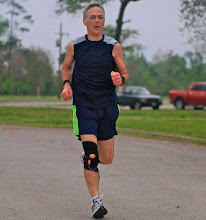Thursday, November 4, 2010
Training Tips Thursday - Run/Walk
I just thought I'd mention the run/walk method. It's a widely used training method, most popularized by Jeff Galloway. I don't use it regularly, but for certain specific training, I found it to be valuable. Here is a link to a good article on Galloway's Run Injury Free with Jeff Galloway page. The article does a good job of explaining the details and recommending different run/walk ratios based on pace. Galloway defines a method for running a marathon, taking scheduled walk breaks through the first 18 miles. I didn't use the method in my first marathon, but I did take a few short unscheduled walk breaks. Perhaps I would have run a better marathon if I'd taken scheduled breaks. For my next marathon, my goal has been to strengthen my overall training enough that I don't have to walk at all.
However, I did find this method very useful in the distance-increasing phase of my first marathon training. When faced with running 16, 18, and 20 miles the first time, I took scheduled walk breaks. Here's how I did it. For example, when I first wanted to run 16 miles, on my first attempt, I alternated two minutes of walking with every eight minutes of running. I found that it really helped me make the distance the first time. The second time I ran 16 miles, I reduced the walking by about half, alternating one minute of walking with every nine minutes of running. By the third time I ran the new distance, I found that I could run the entire distance. I repeated this as I came to each new distance milestone up to 20 miles, and it helped a lot.
However, I did find this method very useful in the distance-increasing phase of my first marathon training. When faced with running 16, 18, and 20 miles the first time, I took scheduled walk breaks. Here's how I did it. For example, when I first wanted to run 16 miles, on my first attempt, I alternated two minutes of walking with every eight minutes of running. I found that it really helped me make the distance the first time. The second time I ran 16 miles, I reduced the walking by about half, alternating one minute of walking with every nine minutes of running. By the third time I ran the new distance, I found that I could run the entire distance. I repeated this as I came to each new distance milestone up to 20 miles, and it helped a lot.
Subscribe to:
Post Comments (Atom)





7 comments:
When I first started running, I couldn't even run a block without feeling like I was going to pass out. I started training by walking/running every minute than two minute run 1 minute walk, and so on. I really helped me be able to run farther without over pushing myself!
Brittany,
Good point! Walk/run works for any distance that we're not used to. When I first started running, I was already a daily walker. I taught myself to run by running a little at a time during my walks, by the same method you describe. The popular "Couch to 5K" training progam works the same way, but I'd never heard of it when I first started running!
Sounds like an interesting plan. I've avoided the run/walk routine because I know I can run distances and want to be able to do so without walking. But I like the idea of building up to a new distance with reduced amounts of walking. May try that.
I'm a huge fan of run/walking!
I feel it's the best way to increase mileage, especially if you're not physically able to run the whole way without breaks.
I know I walk when I can't run anymore because I'm of the mindset that walking > stopping. And after a little walking break, I can just start back up :)
i always take unscheduled breaks when i run... i think i should try a more set run/walk schedule for the next training and see what happens!
I don't regularly use the run/walk method but I will throw in the occasional walk break if I feel I am pushing too hard on one of my training runs.
Purchasing shoes for running and jogging should be done with consideration. Foot health is vital for anyone that is very active such as an avid runner or jogger. Finding the correct shoes that will properly support the feet takes through consideration. While there are a number of shoes that are available on the market not all of them are the same and not all of them are of high quality. To ger more information on good quality running and jogging shoes please visit http://www.goodrunningshoesguide.com/new-balance-1123
Post a Comment